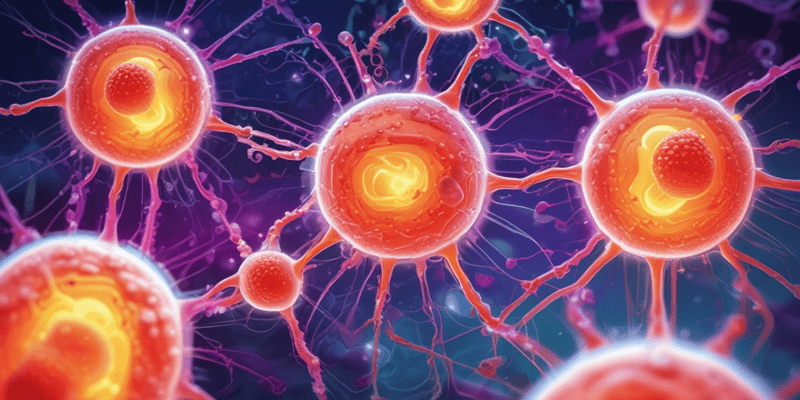29 Questions
What is the main function of cell-to-cell communication?
Coordinating cellular activities
Which type of signal is responsible for most communication within the body?
Chemical signals
What prevents larger molecules from passing through gap junctions?
Size selectivity of gap junctions
Which method of cell-to-cell communication involves surface molecules binding between adjacent cells?
Contact-dependent signals
What type of signals pass directly from cell to cell through gap junctions?
Electrical signals
Which form of communication involves the diffusion of chemicals through the extracellular fluid?
Local communication by chemicals
Which type of intercellular communication involves the release of neurotransmitters at synaptic junctions?
Neural communication
What is the main difference between paracrine and juxtacrine signaling?
Paracrine signals diffuse in the ECF to affect neighboring cells, while juxtacrine signals rely on gap junctions or nanotubes.
What is the primary function of tunneling nanotubes (TNTs) in intercellular communication?
To allow the transfer of organelles, vesicles, and signaling molecules between cells.
Which type of intercellular communication involves the binding of a ligand on one cell surface to a receptor on the surface of the neighboring cell?
Juxtacrine communication
What is the primary function of autocrine signaling in a cell?
To trigger a response in the same cell that secreted the signaling molecule.
Which type of intercellular communication involves the secretion of hormones and growth factors that reach cells via the circulating blood or lymph?
Endocrine communication
What is the process called where receptors become less responsive to a chemical messenger?
Desensitization
What is the name given to the extracellular ligands that bring information to the target cell?
First messengers
Which of the following statements about cell signaling is correct?
Only cells with receptors for a specific hormone can respond to that hormone's signal.
Which step in the signal transduction pathway involves the receptor activating intracellular signal molecules?
The receptor activates intracellular signal molecules
What is the correct sequence of the three stages of cell signaling?
Reception, Transduction, Response
Which of the following is NOT a type of chemical signaling mentioned in the text?
Intracellular signaling
How do second messengers typically influence cell function?
They trigger exocytosis and alter enzyme function
What is the name of the overall process where an external signal is converted into a different form of signal within the cell?
Signal transduction
What happens to the number of active receptors when there is an excess of a hormone or neurotransmitter?
The number of active receptors decreases (downregulation).
In the process of hormonal signaling, how does the hormone reach the target cell?
The hormone travels in the bloodstream to the target cells.
What happens to the number of active receptors when there is a deficiency of a chemical messenger?
There is an increase in the number of active receptors (upregulation).
Which of the following is NOT a gas that acts as an ephemeral signal molecule?
Oxygen (O2)
Which of the following statements about cytokines is true?
All nucleated cells can synthesize and secrete cytokines in response to stimuli
What is the role of leukotrienes in cell-to-cell communication?
They are important paracrine signals with a role in asthma and anaphylaxis
Which of the following statements about prostanoids is correct?
Prostanoids are involved in the regulation of inflammation and pain
What is the primary mechanism by which nonsteroidal anti-inflammatory drugs (NSAIDs) help prevent inflammation?
By inhibiting the enzyme cyclooxygenase (COX)
Which of the following is NOT mentioned as a function of sphingolipids in cell-to-cell communication?
Acting as neurotransmitters in the nervous system
Explore the importance of cell-to-cell communication in maintaining homeostasis, coordinating cellular activities, and controlling growth and development. Learn about the different types of physiological signals such as electrical and chemical signals that regulate intercellular communication.
Make Your Own Quizzes and Flashcards
Convert your notes into interactive study material.
Get started for free



